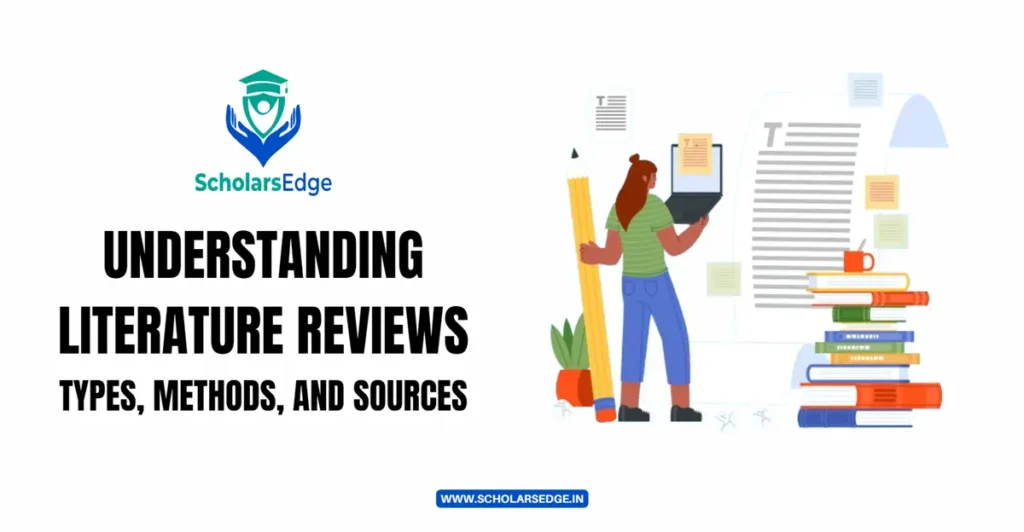
Literature reviews are essential to academic research, serving as a critical foundation for developing new insights and understanding existing knowledge. They help researchers identify gaps, contextualise their studies, and establish a framework for their investigations. In this blog, we’ll explore the different types of literature reviews, the methods used to conduct them, and the sources that form their backbone. Whether new to research or seeking to refine your approach, this guide will provide the tools to navigate the complexities of literature reviews.
What is a Literature Review?
A literature review is a systematic examination of the existing research on a particular topic. It involves collecting, evaluating, and synthesising published work, including books, journal articles, reports, and other scholarly materials. The primary purpose of a literature review is to provide a comprehensive overview of what has already been studied, highlight areas that require further exploration, and offer a critical analysis of existing theories and methodologies.
In contrast to a simple summary of sources, a literature review is analytical and interpretative, connecting different strands of research to present a cohesive narrative. This review summarises findings and critiques them, examining the strengths and weaknesses of existing research.
Purpose of a Literature Review
The purpose of a literature review goes beyond merely summarising existing studies. It serves several key functions in the research process:
- Clarifying the Research Context: By reviewing existing literature, researchers can better understand the context of their study, including the historical background, key debates, and current trends.
- Identifying Research Gaps: A thorough literature review helps pinpoint areas lacking research, guiding researchers to areas that need further investigation.
- Supporting Research Questions or Hypotheses: The literature review provides evidence that supports the formulation of research questions or hypotheses, ensuring they are grounded in existing knowledge.
- Establishing Theoretical Frameworks: A literature review helps identify and define the theoretical frameworks that will be used to analyse the research data.
Types of Literature Reviews
Different types of literature reviews serve other purposes, depending on the nature of the research and the study’s goals. Here are some of the most common types:
- Narrative (Traditional) Review: This review comprehensively summarises the literature on a specific topic. It is often used in humanities and social sciences to give an overview of a particular field or subject. However, it may lack the rigorous methodology of more systematic approaches.
- Systematic Review: A systematic review is a highly structured approach to literature review that seeks to answer a specific research question by identifying, evaluating, and synthesising all relevant studies on the topic. This type of review is commonly used in medical and scientific research to ensure a comprehensive and unbiased overview.
- Scoping Review: Scoping reviews aim to map the existing literature on a broad topic, identifying key concepts, gaps in research, and areas for further study. They are instrumental in emerging fields where the scope of research is not yet well-defined.
- Meta-Analysis: A meta-analysis combines the results of multiple studies to draw broader conclusions about a particular research question. This type of review is quantitative and often used in clinical research to assess the effectiveness of treatments or interventions.
- Thematic Review: Thematic reviews identify and analyse critical themes or concepts within the literature. Qualitative research often uses this approach to explore patterns and relationships across different studies.
- Critical Review: A critical review critically examines the literature, evaluating the strengths and weaknesses of different studies. It goes beyond summarising the literature to provide a deeper analysis of the methodologies and theoretical frameworks used.
Types of Literary Research
Different research approaches are employed in literary studies to analyse texts, contexts, and theories. These include:
- Historical Research: This approach examines literary works within their historical context, exploring how historical events, cultural norms, and societal changes influence the literature of a particular period.
- Comparative Research: Comparative research involves analysing literary texts from different periods, cultures, or genres to identify similarities and differences. This approach helps to uncover universal themes and highlight cultural or temporal differences.
- Textual Analysis: Textual analysis is a close reading of literary texts, focusing on language, structure, and meaning. It is often used to interpret and critique individual works of literature.
- Theoretical Research: This research focuses on literary theories, exploring how different theoretical frameworks can be applied to interpreting texts.
- Contextual Research: Contextual research examines the broader social, cultural, and political contexts in which literary works are produced and received, providing insights into how these factors influence literary production and interpretation.
Sources of Literature Review
The quality of a literature review largely depends on the sources used. These sources can be classified into three main categories:
- Primary Sources: These are original materials or first-hand accounts used as the foundation for analysis. In literature, primary sources include original texts, such as novels, poems, and plays. In other fields, primary sources might consist of research articles, historical documents, or experimental data.
- Secondary Sources: Secondary sources analyse, interpret, or critique primary sources. These include review articles, critical essays, and meta-analyses. Secondary sources are valuable for understanding different perspectives on a topic.
- Tertiary Sources: Tertiary sources provide overviews or summaries of topics, often drawing from primary and secondary sources. Examples include encyclopedias, textbooks, and bibliographies. While tertiary sources are helpful for background information, they are less frequently cited in academic literature reviews.
Literature Review Methods
Different methods can be employed to conduct a literature review, depending on the scope and purpose of the research:
- Comprehensive Literature Review: This method involves an exhaustive search of all relevant literature on a topic. It requires a detailed analysis and synthesis of findings from various sources.
- Targeted Literature Review: A targeted review focuses on specific aspects of a topic, narrowing the search to the most relevant sources. This approach is practical when the research question is particular.
- Annotated Bibliography: An annotated bibliography lists sources and provides a summary and evaluation of each. This method is often used as a preliminary step in the literature review process.
- Conceptual Review: A conceptual review explores and defines key concepts within the literature, often seeking to clarify definitions or theoretical frameworks.
- Integrative Review: An integrative review synthesises diverse sources to develop new insights or theories, combining elements from different studies to form a cohesive understanding of the topic.
Methodology in Literature Reviews
The methodology section of a literature review outlines the approach taken to identify, select, and analyse sources. Key steps include:
- Developing a Search Strategy involves identifying key terms and databases to search for relevant literature. It also includes documenting the search process to ensure transparency.
- Screening and Selection Criteria: Researchers must establish criteria for including or excluding sources, ensuring that only relevant and high-quality studies are considered.
- Data Extraction and Analysis: This step involves extracting key information from the selected sources and synthesising the findings to conclude.
Background Literature Review
A background literature review sets the stage for new research by providing context and grounding the study in existing knowledge. It helps establish the research question’s relevance and demonstrates how the new study will contribute to the field.
Conclusion
Conducting a literature review is a complex yet crucial step in the research process. It requires a deep understanding of the different types, methods, and sources that can be employed. By systematically reviewing and analysing the existing literature, researchers can build a solid foundation for their studies, ensuring that their work is informed by and contributes to the broader academic conversation. Whether embarking on a new research project or refining an ongoing study, mastering the art of literature reviews is key to producing high-quality, impactful research.
FAQs on Literature Reviews
What are the different types of literature review?
Literature reviews come in several types, each serving a distinct purpose in research. The most common types include narrative (traditional) reviews, which provide a broad overview of a topic; systematic reviews, which offer a rigorous and structured analysis of all relevant studies; scoping reviews, which map the scope of existing literature; meta-analyses, which statistically combine results from multiple studies; thematic reviews, which focus on identifying key themes; and critical reviews, which evaluate and critique the literature comprehensively.
How many types of literature reviews are there?
Several literature reviews are typically categorised into six main types: narrative (traditional) reviews, systematic reviews, scoping reviews, meta-analyses, thematic reviews, and critical reviews. Each type is designed for different research goals, from broad overviews to detailed, quantitative syntheses. The choice of literature review type depends on the research question, the scope of the study, and the discipline in which the research is conducted.
